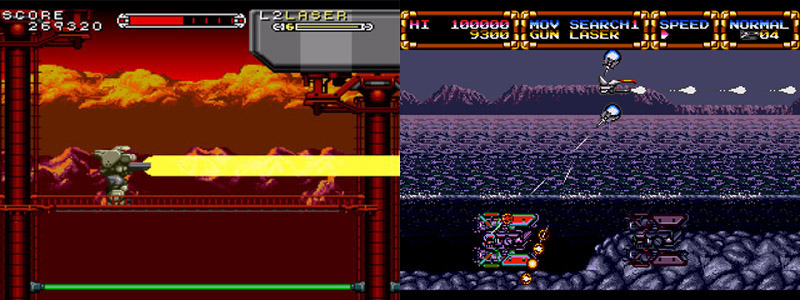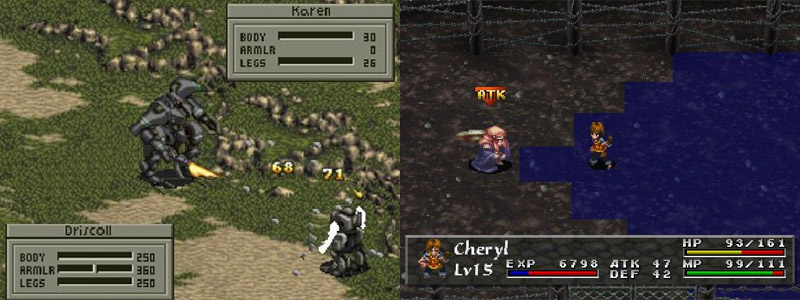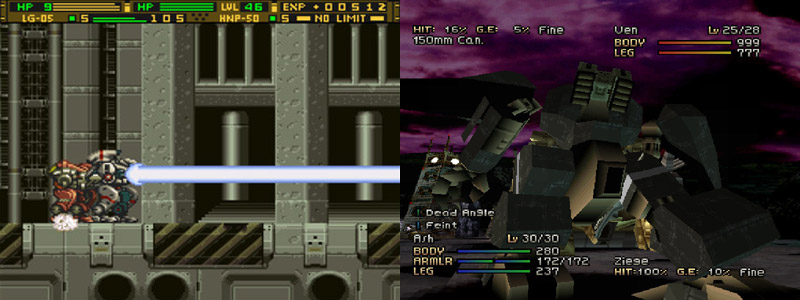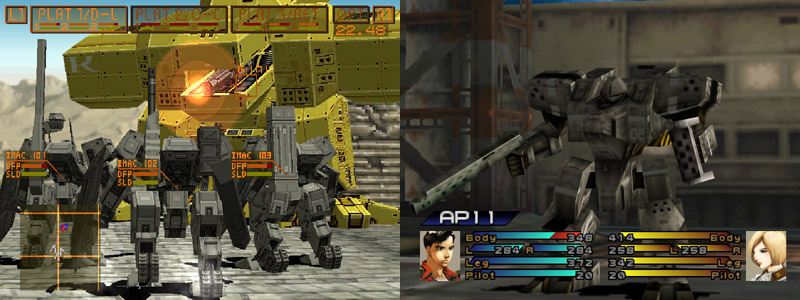TheDevelopersOfFrontMission
The Developers of Front Mission
- Introduction
- Humble Beginnings: The Masaya Days
- Coming of Age: The G-Craft Days
- Enter Square: The R&D 7 Days
- The Team
Front Mission is one of the longest-running and oldest franchises from Square Co., Ltd. dating back to before their merger with Enix Corporation. The franchise has a storied history on the development side of things, from its outsourced roots to the in-house development era. From G-Craft to Square Research & Development (R&D 7) to Square Enix Product Development Division 6 (PDD6), there's a lot to learn about the men and women involved in creating Front Mission.
Humble Beginnings: The Masaya Days

Classic cult hits - Assault Suits Valken and Advanced Busterhawk Gleylancer.
Years before Front Mission was conceived, the team of developers who would later be known for creating the franchise were part of Japanese development studio Masaya. Masaya was well-known for their 2D action and side-scrolling shooter video games, most notably the Assault Suits series. Most of their games, such as Advanced Busterhawk Gleylancer, were never considered for localization and remained in Japan only. The few that did, however, have become cult hits. One of them was Assault Suits Valken, or Cybernator (as it was renamed by Konami) for the Super Nintendo Entertainment System (SNES).
Released in Japan in 1992, Assault Suits Valken was a 2D side-scrolling shooter based around the Assault Suits universe. Featuring detailed backgrounds, smooth and fluid action, responsive controls, and a mature storyline (for its time), the game was a sleeper hit that impressed many. The story starred a new Assault Suit pilot as he participates in a war involving territorial rights to the moon and its natural resources. Much of its mature content, such as the graphic suicide of a certain character, were censored in the English localization. This was likely done out of the consideration that video games were considered "child's toys" back then.
From its usage of realistically designed mecha to the political overtones of the storyline, Assault Suits Valken would later become one of the blueprints for Front Mission. In some ways, the game could be considered as the spiritual predecessor to the franchise.
Coming of Age: The G-Craft Days

A paradigm shift from real-time action to turn-based strategy - Front Mission and Arc the Lad.
In late 1993, a group of Masaya developers led by Toshiro Tsuchida founded the studio, G-Craft. Rather than continue to work on action-oriented titles, the team ventured into the turn-based strategy realm. This was evident in their newly created intellectual properties, or IPs - Front Mission and Arc the Lad. The two share many common elements, from the turn-based gameplay to the fact that both were initially outsourced from Square Co., Ltd. and Sony Computer Entertainment respectively. Both Front Mission and Arc the Lad also contained serialized stories that were planned in advance, akin to the serial television drama Lost.
However, the two franchises also differ in one major aspect. Whereas Arc the Lad was planned as a fantasy-based epic, Tsuchida had a much more ambitious vision for Front Mission. Heavily inspired by the real world itself, as well as other works ranging from Ghost in the Shell, Full Metal Jacket, and Rashomon, he set out to create "a realistic impression of the world's future." And so, in early 1994, Front Mission was born.
While it would be another year before the game was officially released on the SNES, Tsuchida and his writers began to plot out the series piece by piece. Not content with telling the story through video games alone, Tsuchida intended to have Front Mission told through various media. These included books, film, and even radio itself. Much like how a serial drama handles its expanded universe material, all of these mediums would come together to tell the full story.
The release of Front Mission for the SNES in February 1995, along with expanded universe supplements released in late 1994, set the saga in motion. Featuring a narrative with mature overtones and disturbing plot material, the video game shocked many players during its time of release. A story of a soldier coping with post-traumatic stress disorder from the death of his fiancee and being blamed for inciting a major war was unheard of. The lack of a true "happy" ending and closure surprised many who thought Front Mission would have a traditional Square-styled storyline.
When asked about these details in follow-up interviews, Tsuchida and his team at G-Craft explained that Front Mission was designed to present a realistic outlook of the world from all angles. The series visionary also informed Japanese fans about Front Mission as a serialized story, as this was only the beginning of the saga. This information intrigued the fans and thereby led to the growth of Front Mission in Japan. Square Co., Ltd. was also interested in seeing Toshiro Tsuchida's full vision and began promoting the franchise across various media.
While Front Mission captivated the hearts of Square fans, Sony fans were treated to the fantasy-based adventures of a young boy in Arc the Lad for the PlayStation. Like Front Mission, Arc the Lad was well received in Japan and created a strong following among the fans. Unfortunately, both of these video games were never localized overseas despite plans from Square Co., Ltd. and Sony Computer Entertainment Inc. to do so. Both franchises would continue on with new video game entries in 1996.

Ventures outside the status quo - Front Mission: Gun Hazard and Front Mission 2.
Released in February 1996 for the SNES, Front Mission: Gun Hazard represented a detour for the series, as a 2D side-scrolling shooter similar to Assault Suits Valken. The game's story was also unusual in that it took place in a separate universe from the one created for Front Mission. Although it was developed by Omiya Soft, many G-Craft developers were also on-board for Front Mission: Gun Hazard. Despite the changes, this entry was well received by the fans for its expanded play mechanics (as it was essentially Assault Suits Valken in disguise) and strong, mature story.
Arc the Lad II on the PlayStation continued the story of Arc and greatly expanded on the world presented in Arc the Lad. Featuring a much longer game with a more developed storyline and improved play mechanics, the game was a major success critically and commercially. Arc the Lad II sold nearly one million units in Japan and was one of the highest selling titles during that year. Players praised the game for fixing faults from the original, as well as its more mature overtones similar to ones from Front Mission. Its success spawned an anime as well as a radio drama.
After the release of Arc the Lad II, Square Co., Ltd. became interested in buying out G-Craft. The deal was eventually sealed some time during 1997. At the time, G-Craft was developing both Front Mission 2 and Front Mission Alternative. As Front Mission 2 was nearing completion during the time of the buyout, it was the last game G-Craft was credited for officially. Front Mission Alternative would be credited as Square Research & Development 7 (R&D 7) a few months after the release of Front Mission 2.
Released in September 1997 on the PlayStation, Front Mission 2 was a return to turn-based strategy. It was also the first entry to utilize 3D graphics. Featuring a heavier emphasis on politics, the game featured an ensemble cast of characters, depicting their experiences in the midst of a violent revolution in an impoverished country. Mature overtones from the original were expanded upon in many ways, from topics such as colonial dependency. Front Mission 2 also boasted many new play mechanics, most of which would later be featured in future entries. Despite some accessibility issues, namely long loading times, the game was well received by fans and critics.

Officially squared - Front Mission Alternative and Front Mission 3.
As R&D 7, the team released Front Mission Alternative in December 1997 on the PlayStation. Like Front Mission: Gun Hazard, the game was another genre spin-off, this time as real-time strategy (RTS). While the story was set in the main Front Mission universe, it is set farthest away from the timeline. In short, it's a prequel of the things to come in the main storyline. The game was one big experiment, from the play mechanics to the fully realized 3D graphics, and even the music itself. Despite enduring criticism because of these changes, Front Mission Alternative is a pivotal entry in that many of its play mechanics are later incorporated into the turn-based entries.
Up to this point, no Front Mission video game had received a localization. However, this changed with Front Mission 3 on the PlayStation. Released in Japan on September 1999, it was also the first game to be localized for North America and Europe. While the game returned to its turn-based strategy roots, it was also a big change from its predecessors. The depth found in previous entries was either removed or downgraded in exchange for user accessibility. Likewise, the story was written to be more palatable to a younger audience. While newcomers enjoyed the game as a result, Front Mission 3 was seen as a regression by series veterans.
Beyond the two Front Mission titles, the team's days as R&D 7 were short-lived. Due to the upcoming release of Final Fantasy: The Spirits Within and implementation of PlayOnline, developers from the company's internal teams were laid off. This, however, did not stop R&D 7 from further trying to expand the franchise.
Click here for Part Two, or here for Part Three.
